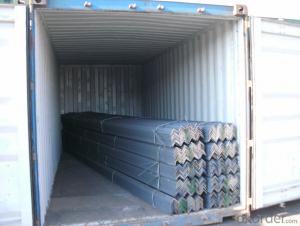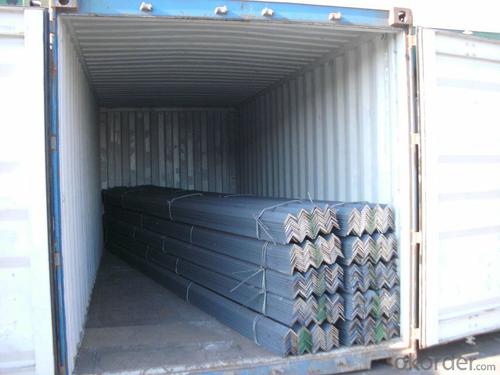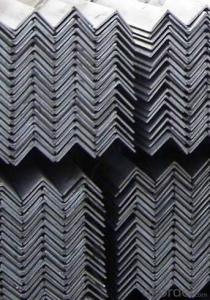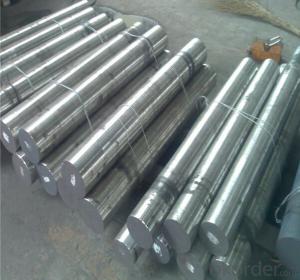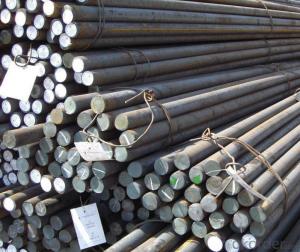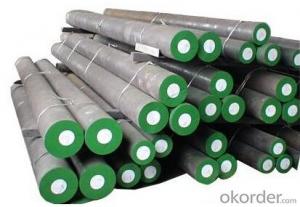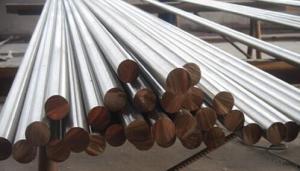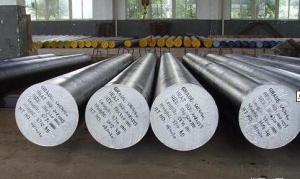Supply 2015 Alloy Steel Angle Bar from CNBM
- Loading Port:
- Tianjin
- Payment Terms:
- TT OR LC
- Min Order Qty:
- 25 m.t.
- Supply Capability:
- 20000 m.t./month
OKorder Service Pledge
OKorder Financial Service
You Might Also Like
Specification
OKorder is offering high quality Hot Rolled Steel Angle at great prices with worldwide shipping. Our supplier is a world-class manufacturer of steel, with our products utilized the world over. OKorder annually supplies products to European, North American and Asian markets. We provide quotations within 24 hours of receiving an inquiry and guarantee competitive prices.
Product Applications:
Hot Rolled Steel Angles are ideal for structural applications and are widely used in the construction of buildings and bridges, and the manufacturing, petrochemical, and transportation industries.
Product Advantages:
OKorder's Steel Angles are durable, strong, and resist corrosion.
Main Product Features:
· Premium quality
· Prompt delivery & seaworthy packing (30 days after receiving deposit)
· Corrosion resistance
· Can be recycled and reused
· Mill test certification
· Professional Service
· Competitive pricing
Product Specifications:
Manufacture: Hot rolled
Grade: Q195 – 235
Certificates: ISO, SGS, BV, CIQ
Length: 6m – 12m, as per customer request
Packaging: Export packing, nude packing, bundled
Sizes: 25mm-250mm | ||
a*t | ||
25*2.5-4.0 | 70*6.0-9.0 | 130*9.0-15 |
30*2.5-6.6 | 75*6.0-9.0 | 140*10-14 |
36*3.0-5.0 | 80*5.0-10 | 150*10-20 |
38*2.3-6.0 | 90*7.0-10 | 160*10-16 |
40*3.0-5.0 | 100*6.0-12 | 175*12-15 |
45*4.0-6.0 | 110*8.0-10 | 180*12-18 |
50*4.0-6.0 | 120*6.0-15 | 200*14-25 |
60*4.0-8.0 | 125*8.0-14 | 250*25 |
FAQ:
Q1: Why buy Materials & Equipment from OKorder.com?
A1: All products offered byOKorder.com are carefully selected from China's most reliable manufacturing enterprises. Through its ISO certifications, OKorder.com adheres to the highest standards and a commitment to supply chain safety and customer satisfaction.
Q2: How do we guarantee the quality of our products?
A2: We have established an advanced quality management system which conducts strict quality tests at every step, from raw materials to the final product. At the same time, we provide extensive follow-up service assurances as required.
Q3: How soon can we receive the product after purchase?
A3: Within three days of placing an order, we will begin production. The specific shipping date is dependent upon international and government factors, but is typically 7 to 10 workdays.
Alloy No | Grade | Element (%) | ||||
C | Mn | S | P | Si | ||
Q235 | B | 0.12—0.20 | 0.3—0.7 | ≤0.045 | ≤0.045 | ≤0.3 |
Alloy No | Grade | Yielding strength point( Mpa) | ||||
Thickness (mm) | ||||||
≤16 | >16--40 | >40--60 | >60--100 | |||
≥ | ||||||
Q235 | B | 235 | 225 | 215 | 205 | |
Alloy No | Grade | Tensile strength (Mpa) | Elongation after fracture (%) | |||
Thickness (mm) | ||||||
≤16 | >16--40 | >40--60 | >60--100 | |||
≥ | ||||||
Q235 | B | 375--500 | 26 | 25 | 24 | 23 |
Images:

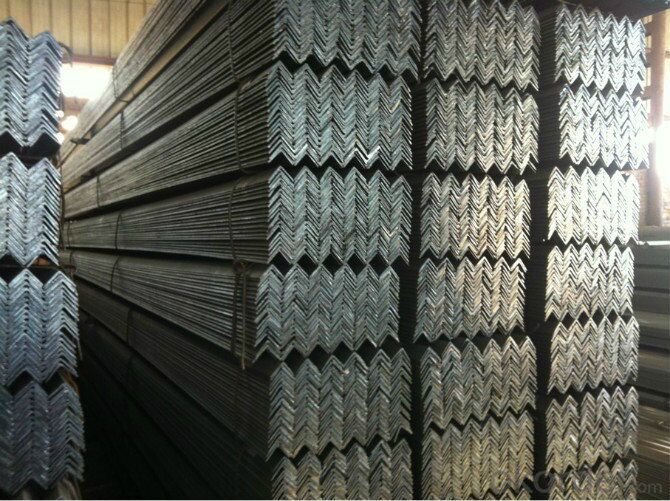
- Q: Are steel angles magnetic?
- Yes, steel angles are magnetic. Steel is a ferromagnetic material, which means it can be magnetized and attracted to a magnet. Steel angles, being made of steel, inherit this magnetic property. The presence of iron, along with other elements, in the composition of steel makes it responsive to magnetic fields. This property is often utilized in various applications such as in the construction industry, where steel angles are commonly used for structural support.
- Q: What is the minimum thickness for a steel angle beam?
- The minimum thickness for a steel angle beam depends on various factors such as the load it needs to support, the length of the beam, and the specific steel grade being used. Generally, the minimum thickness for a steel angle beam is determined by structural engineers or professionals in the field, who consider the specific application and design requirements. Steel angle beams are commonly used in construction, framing, and other structural applications. They are designed to provide support and stability, particularly in load-bearing situations. The thickness of the steel angle beam is crucial to ensure its strength and ability to bear the intended load without deformation or failure. To determine the minimum thickness, engineers consider factors such as the maximum load that the beam will experience, the length of the beam, the material properties of the steel being used, and the safety factor required for the application. They use mathematical calculations and structural analysis to determine the appropriate thickness that will meet the necessary structural requirements. It is important to note that there are specific industry standards and building codes that must be followed when designing and constructing steel angle beams. These standards provide guidelines and requirements for minimum thickness, as well as other aspects such as tolerances, dimensions, and connection details. Therefore, it is always recommended to consult with a qualified structural engineer or professional in the field to determine the minimum thickness for a steel angle beam based on the specific requirements of the project. They will consider all relevant factors and ensure that the beam is designed and constructed to provide the necessary strength and safety.
- Q: How can steel angles be protected against corrosion?
- Steel angles can be protected against corrosion through various methods such as applying protective coatings like paint or galvanization, using corrosion inhibitors, implementing cathodic protection systems, or selecting stainless steel angles which are inherently resistant to corrosion.
- Q: Can steel angles be recycled?
- Yes, steel angles can be recycled. Steel is one of the most recycled materials in the world, and steel angles are no exception. When steel angles are no longer needed or reach the end of their lifecycle, they can be collected, processed, and turned into new steel products. Recycling steel angles helps to conserve natural resources, reduce energy consumption, and minimize waste. This makes steel angles a sustainable and environmentally friendly choice for construction and other applications.
- Q: How do you calculate the bending moment of a loaded steel angle?
- To calculate the bending moment of a loaded steel angle, you need to consider the applied load, the moment arm, and the cross-sectional properties of the angle. First, determine the applied load acting on the steel angle. This could be a point load or a distributed load, depending on the specific situation. Next, locate the point of application of the load and determine the moment arm. The moment arm is the perpendicular distance between the point of application of the load and the axis of rotation. Once you have the applied load and the moment arm, you can calculate the bending moment using the formula: Bending Moment = Applied Load x Moment Arm Finally, you need to consider the cross-sectional properties of the steel angle. These include the area moment of inertia (I) and the section modulus (Z). The area moment of inertia measures the resistance to bending and depends on the shape and dimensions of the angle. The section modulus represents the strength of the section and is calculated as the ratio of the area moment of inertia to the distance from the centroid to the extreme fiber. By using the appropriate equations and considering the cross-sectional properties, you can determine the bending moment capacity of the loaded steel angle and assess its structural integrity under the given load conditions.
- Q: What are the common standards and specifications for steel angles?
- The common standards and specifications for steel angles vary depending on the application and the country in which they are being used. However, some widely recognized standards and specifications include: 1. ASTM A36/A36M: This is a standard specification for carbon structural steel, including steel angles. It covers shapes such as angles, channels, and beams, and specifies the chemical composition, mechanical properties, and other relevant requirements. 2. ASTM A529/A529M: This specification covers high-strength carbon-manganese steel shapes, including angles, used in construction. It provides requirements for chemical composition, mechanical properties, and other important characteristics. 3. ASTM A572/A572M: This specification covers high-strength low-alloy structural steel shapes, including angles. It specifies the chemical composition, mechanical properties, and other relevant requirements for these shapes used in construction applications. 4. EN 10056: This European standard specifies the tolerances on shape, dimensions, and mass of hot-rolled structural steel equal and unequal angles. It provides requirements for the chemical composition, mechanical properties, and other characteristics of steel angles. 5. JIS G3192: This Japanese industrial standard specifies the dimensions, mass, and tolerances for hot-rolled steel sections, including angles. It sets forth the requirements for chemical composition, mechanical properties, and other relevant specifications. These are just a few examples of the commonly used standards and specifications for steel angles. It is important to consult the specific regulations and standards applicable to the region and application in order to ensure compliance and meet the desired requirements.
- Q: What are the different types of steel angle connections?
- Construction and engineering projects commonly incorporate several different types of steel angle connections. Among the main types are the following: 1. Traditional and widely used, welded connections join steel angles by welding them at the point of contact. These connections offer exceptional strength and rigidity, making them ideal for heavy-duty applications. 2. Bolted connections involve using bolts and nuts to fasten the steel angles together. This method allows for easy disassembly and reassembly of the structure, which is useful when frequent adjustments or modifications are necessary. 3. Riveted connections utilize rivets to join the steel angles together. Rivets are inserted through pre-drilled holes in the angles and secured by hammering or pressing. Although riveted connections were commonly used in older structures, they are still occasionally employed in certain applications today. 4. Clipped connections, a type of bolted connection, use special clip angles to connect the angles. These clip angles are bolted to the main angles, creating a secure and rigid connection. Clipped connections find frequent use in steel trusses and frameworks. 5. Gusset plate connections involve using a steel plate, known as a gusset plate, to connect two or more steel angles. The gusset plate is typically bolted or welded to the angles, providing additional strength and stability. This type of connection is often employed in structures subjected to heavy loads or dynamic forces. Each type of steel angle connection possesses its own advantages and disadvantages. The choice of connection method depends on various factors, including load requirements, structural design, and project specifications.
- Q: Are steel angles resistant to UV radiation or fading?
- No, steel angles are not inherently resistant to UV radiation or fading. Steel, by nature, is susceptible to oxidation and corrosion when exposed to UV radiation and atmospheric conditions. Over time, the UV radiation can cause the steel to fade, lose its luster, and develop a patina. However, steps can be taken to mitigate the effects of UV radiation on steel angles. Applying protective coatings, such as paint or galvanizing, can provide a barrier against UV radiation and help prevent fading. Regular maintenance and proper care can also extend the lifespan and appearance of steel angles when exposed to UV radiation.
- Q: Can steel angles be easily modified or customized on-site?
- Steel angles have the capability to be effortlessly modified or customized on-site. One can cut, drill, weld, and bend steel angles to meet specific requirements. This adaptability permits convenient customization and adjustment of steel angles to fulfill diverse construction or fabrication needs. Moreover, on-site modifications are frequently essential to guarantee accurate fitting and alignment during installation. By utilizing the appropriate tools and expertise, steel angles can be modified and customized on-site with minimal difficulty.
- Q: Can steel angles be cut to custom lengths?
- Yes, steel angles can be cut to custom lengths. Steel angles, also known as angle irons, are versatile structural components commonly used in construction and manufacturing. They are available in various standard sizes, but they can also be customized to meet specific length requirements. This can be achieved by using cutting tools such as saws or shears to trim the steel angle to the desired length. The ability to cut steel angles to custom lengths makes them suitable for a wide range of applications, as they can be tailored to fit specific design needs.
Send your message to us
Supply 2015 Alloy Steel Angle Bar from CNBM
- Loading Port:
- Tianjin
- Payment Terms:
- TT OR LC
- Min Order Qty:
- 25 m.t.
- Supply Capability:
- 20000 m.t./month
OKorder Service Pledge
OKorder Financial Service
Similar products
Hot products
Hot Searches
Related keywords
